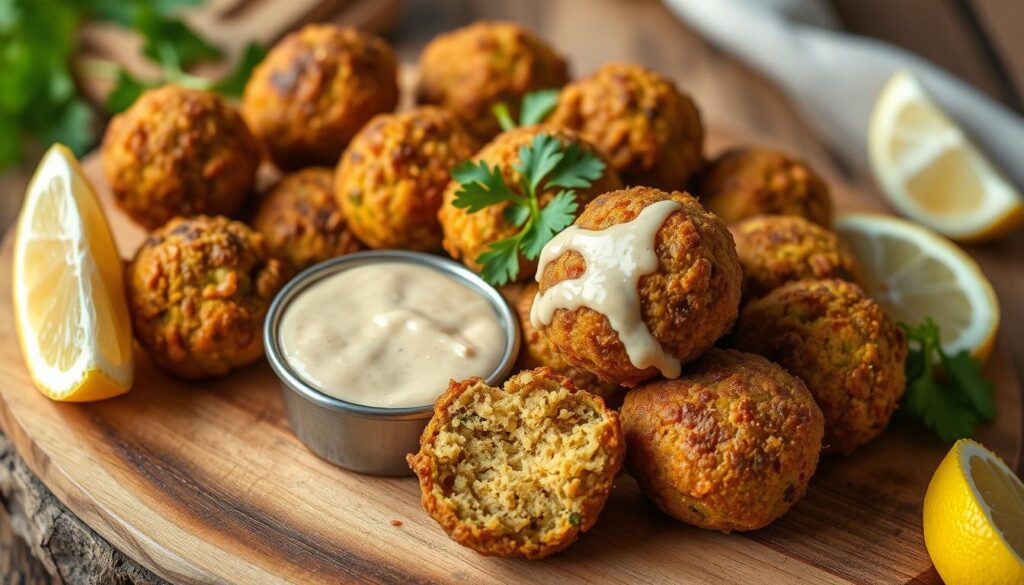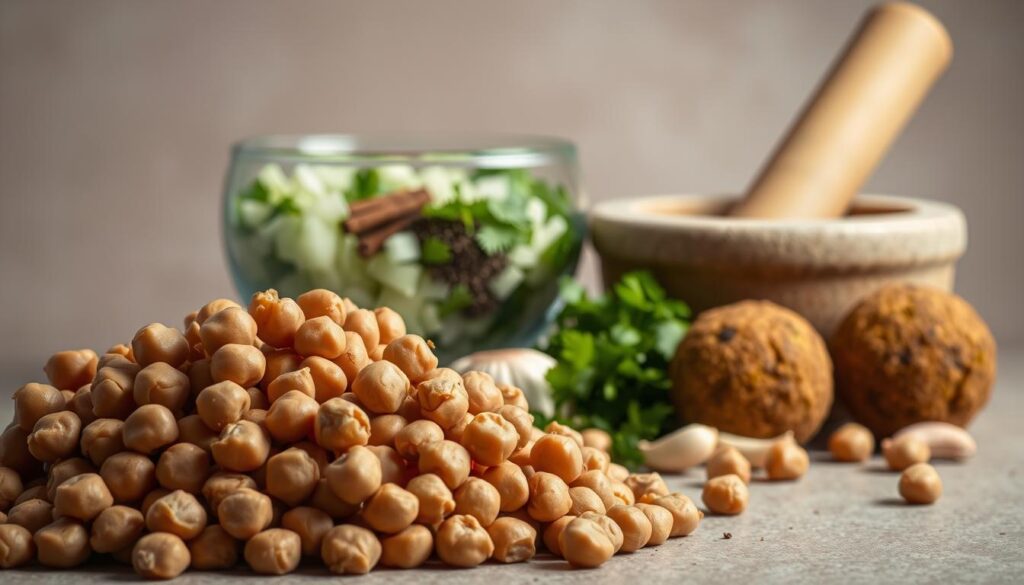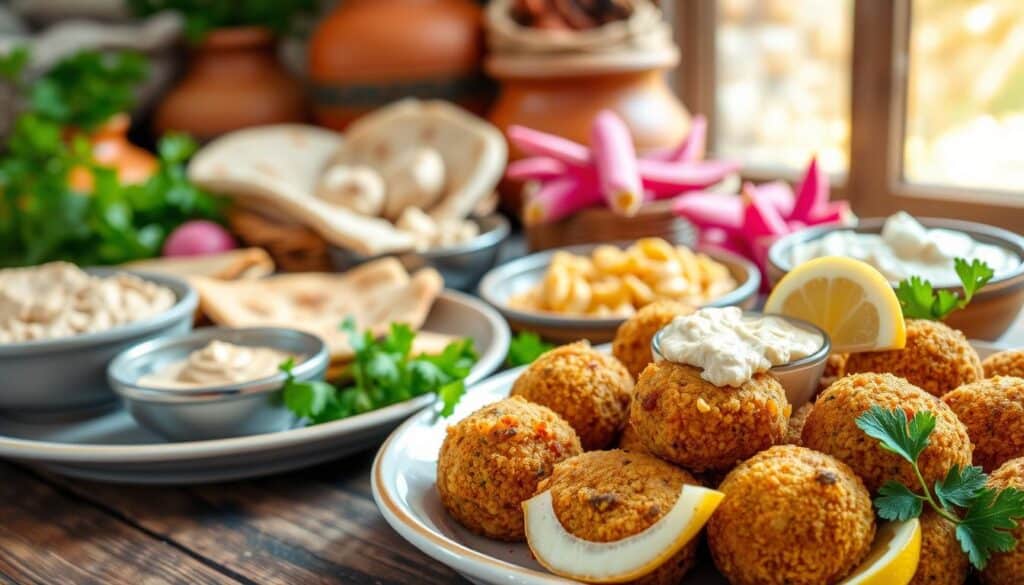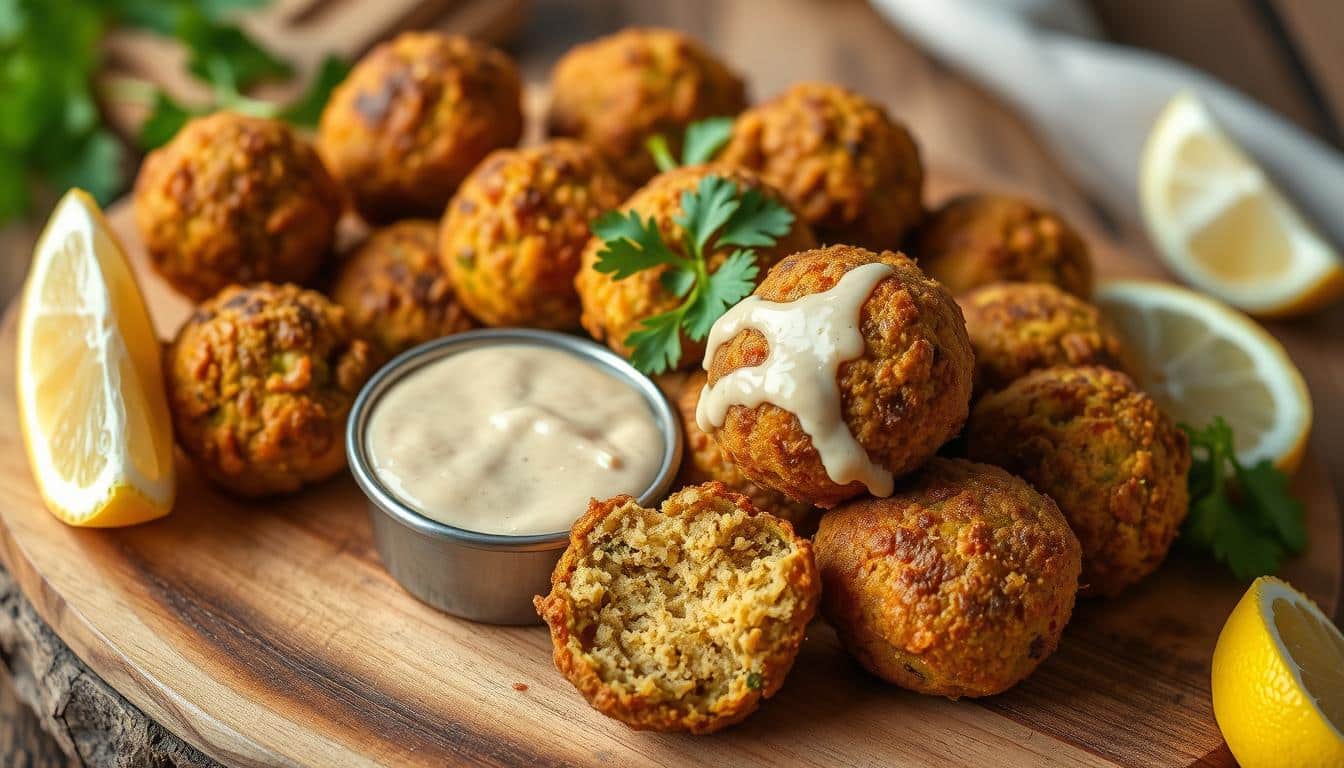There’s something special about biting into a crispy, flavorful falafel. Discover the Taste of Falafel. It’s more than just a meal; it’s an experience that connects you to the vibrant streets of the Middle East. My journey with falafel began when I first tried it at a local market. The combination of crunchy outside and soft inside, drizzled with creamy tahini sauce, was love at first bite.
Thank you for reading this post, don't forget to subscribe!So, what exactly is falafel? It’s a vegetarian delight made from ground chickpeas, fresh herbs, and aromatic spices. The process starts with dried chickpeas soaked overnight, blended with garlic, onion, and spices, then shaped into patties and cooked to perfection. Whether you fry, bake, or pan-fry them, each method brings out a unique flavor.
Making falafel at home is easier than you think. I use a food processor to blend the ingredients into a coarse mixture, ensuring the perfect texture. Fresh ingredients like parsley and tahini sauce are essential for that authentic taste. It’s amazing how something so simple can be so rewarding.
Discover the Taste of Falafel: Fried Chickpea Balls

Key Takeaways
- Falafel is a traditional Middle Eastern street food made from chickpeas.
- It’s versatile—enjoy it in a pita, salad, or as a snack.
- A food processor helps achieve the ideal texture for the mixture.
- Fresh ingredients enhance the flavor and authenticity.
- Making falafel at home is simple and rewarding.
Introduction to Falafel as a Versatile Meal and Snack
Discovering the versatility of falafel has been a game-changer in my kitchen. This Middle Eastern delight isn’t just a snack; it’s a meal, an appetizer, and even a conversation starter. Whether you’re grabbing it on the go or serving it at a gathering, falafel’s adaptability shines.
My Personal Journey with Falafel
My love affair with falafel began with a single bite at a local market. That crispy exterior and fluffy interior, drizzled with tahini sauce, was pure magic. Inspired, I decided to recreate it at home, experimenting with various cooking techniques like frying, baking, and even air frying. Each method brought its own charm, and soon, falafel became a staple in my kitchen.
Why Homemade Falafel Stands Out
Homemade falafel offers a unique texture that’s hard to find elsewhere. The balance between a crunchy outside and a tender inside is key. Using high-quality chickpeas and the right amount of oil ensures that perfect crisp exterior. Baking is a great alternative, providing a healthier option without sacrificing flavor.
What makes homemade falafel truly special is the ability to customize. From the spices to the cooking method, every choice impacts the final product. It’s not just about the taste; it’s about the experience. A well-crafted falafel recipe can elevate any meal, making it a versatile choice for any time of day.
The History and Cultural Origins of Falafel
Falafel’s journey from a humble street food to a global culinary icon is a story worth exploring. Originating in the Middle East, this flavorful patty has deep roots in Egyptian and Levantine cuisines, making it a beloved dish across cultures.
Roots in Middle Eastern Cuisine
The history of falafel is as rich as its taste. With roots tracing back to ancient Egypt, where fava beans were initially used, this dish later evolved to feature chickpeas in many regions. The mixture of chickpeas, garlic, and tahini creates a patty that’s both nutritious and delicious. This blend reflects the diverse cultural influences that have shaped Middle Eastern cuisine over centuries.
Evolution of the Street Food Classic
From street vendors to modern restaurants, falafel’s popularity has soared. What once was a simple snack has become a staple in menus worldwide. Interestingly, it only takes a few minutes to fry a perfectly formed patty, yet the technique and flavors behind it are steeped in history. The combination of traditional ingredients and spices continues to captivate palates, making falafel a timeless favorite.
As I delve into the history of falafel, I appreciate how it brings people together. Whether enjoyed in a pita, salad, or as a snack, each bite tells a story of cultural heritage and culinary evolution. This dish isn’t just food; it’s a connection to the past and a celebration of diversity.
Learn moreabout the fascinating history of falafel and its journey from local streets to global fame.
Essential Ingredients and Tools for Authentic Falafel
Creating authentic falafel starts with the right ingredients and tools. These elements are crucial for achieving that perfect blend of flavors and textures.
Key Ingredients: Chickpeas, Herbs, and Spices
The foundation of great falafel is dried chickpeas, which must be soaked overnight. Fresh herbs like parsley and cilantro add vibrant flavors, while spices such as cumin, coriander, and a touch of cayenne pepper enhance the aroma. Onion and garlic provide a savory base, and a splash of water helps bind the mixture without making it too soggy.
Kitchen Tools and Equipment Needed
A sturdy food processor is indispensable for blending ingredients to the perfect consistency. Mixing bowls and a reliable frying pan are also must-haves. Using the right oil, like avocado or peanut oil, ensures a crispy exterior without burning.

With these ingredients and tools, you can craft falafel that’s both flavorful and crisp, just like the ones from your favorite Middle Eastern restaurant.
Falafel: Fried balls chickpeas – Mastering the Texture and Binding
When it comes to crafting the perfect falafel, texture and binding are everything. I’ve learned that using the right ingredients and techniques makes all the difference.
Choosing Between Dry and Canned Chickpeas
Dry chickpeas are my go-to choice. Soaking them overnight ensures they bind well and have a better texture. Canned chickpeas are softer and can make the mixture too soggy.
Techniques for Achieving the Perfect Consistency
I use a food processor to blend the chickpeas into a coarse mixture. It’s important not to over-process. Letting the mixture rest overnight helps the flavors meld together and improves texture.
| Chickpea Type | Texture | Binding Quality |
|---|---|---|
| Dry Chickpeas | Coarse, holds shape | Excellent binding |
| Canned Chickpeas | Soft, mashed | Poor binding |
Frying at the right temperature and not overcrowding the pan ensures each falafel holds its shape. A little patience and the right techniques make all the difference in creating that perfect crunch and texture.
Cooking Techniques: Frying, Baking, and Air Frying Falafel
Exploring different cooking methods for falafel has been an exciting journey. Each technique offers unique textures and flavors, allowing you to choose based on your preferences and dietary needs.
Deep Frying for Ultimate Crispiness
Deep frying is my go-to method for that irresistible crunch. I heat about 4 inches of neutral oil in a deep pan to the right temperature. It takes just 2-3 minutes per side to achieve that golden, crispy exterior while keeping the inside tender. The result is well worth the extra oil.
Oven Baking and Air Frying Options
Oven baking and air frying are fantastic alternatives for a healthier take. Preheating the oven to 375°F, I bake for 20-22 minutes, flipping halfway. Air frying at 400°F takes only 7 minutes, with a quick flip at the 4-minute mark. Both methods yield delicious results with much less oil.
Regardless of the method, fresh parsley adds a vibrant touch and fresh flavor. I also keep an eye on the time—whether it’s a few minutes in the fryer or up to an hour in the oven—to ensure perfection without overcooking.
| Method | Temperature | Time |
|---|---|---|
| Deep Frying | 350°F | 2-3 minutes per side |
| Oven Baking | 375°F | 20-22 minutes |
| Air Frying | 400°F | 7 minutes total |
For a quicker and healthier option, I recommend trying the air fryer method. Each technique ensures every falafel is perfectly cooked, offering a delightful experience every time.
Accompaniments and Serving Suggestions
Finding the perfect sides to go with your dish can elevate the entire meal. For me, the right accompaniments make all the difference in enjoying a flavorful experience.
Tahini Sauce and Yogurt Dip Essentials
A creamy tahini sauce or a refreshing yogurt dip adds a tangy contrast to the crispy texture. I love how these dips complement the smoky flavor, creating a balanced taste. For an extra touch, a sprinkle of ground spices like cumin or paprika can enhance the aroma and flavor.
Served in Pitas, Salads, and Wraps
Stuffed into a warm pita or tossed into a fresh salad, the options are endless. I enjoy mixing them with crisp vegetables for a light meal or wrapping them in flatbread for a quick snack. The versatility allows me to experiment with different combinations every time.
| Method | Texture | Spice Usage |
|---|---|---|
| In Pita | Crispy and soft | Light cumin and paprika |
| In Salad | Fresh and crunchy | Mint and sumac |
| In Wrap | Soft and warm | Chili powder and garlic |

Whether you choose to fry or bake, the key is to let the natural flavors shine. A pinch of ground spices can transform a simple dish into something extraordinary, making every bite a delightful experience.
Health Benefits and Nutritional Facts of Falafel
Falafel isn’t just delicious—it’s also packed with nutrients. A 100-gram serving of homemade falafel contains about 333 calories, 13.3 grams of protein, and 4.9 grams of dietary fiber. This makes it an excellent choice for a balanced meal.
Nutritional Insights from Trusted Sources
According to nutritional data, falafel is rich in essential vitamins and minerals. It provides 26% of the daily value for folate and 20% for magnesium. These nutrients support energy production and overall health.
Falafel in a Balanced Diet
I love how falafel fits into my healthy lifestyle. It’s high in fiber and protein, which helps keep me full longer. Plus, baking or air frying reduces fat content, making it a guilt-free option. Here’s a quick comparison of cooking methods:
| Method | Calories per Serving | Fat Content |
|---|---|---|
| Deep Fry | 350 | 17.8g |
| Oven Baked | 250 | 3g |
| Air Fried | 220 | 2.5g |
By choosing healthier cooking methods and fresh ingredients, falafel can be a nutritious part of your diet. It’s all about balance and making mindful choices.
Tips and Tricks for Perfect Homemade Falafel
Perfecting homemade falafel is all about the details. From soaking beans to achieving the right texture, every step matters. Let’s dive into some essential tips to make your homemade falafel stand out.
Preparation and Soaking Techniques
Start with dried beans for the best results. Soak them in cold water for 24 hours to ensure they absorb enough moisture. This step is crucial for texture and flavor. After soaking, drain and rinse the beans before blending them with fresh herbs like cilantro and parsley. These herbs add a vibrant flavor that complements the earthy taste of the beans.
Common Troubleshooting and Binding Tips
If your mixture falls apart, don’t panic! Add a little flour or chickpea flour to bind it. Shaping the mixture by hand ensures each piece holds together well. For extra crispiness, let the shaped mixture rest for about 30 minutes before cooking. This simple step can make a big difference in the final texture.
Experiment with spices to enhance the flavor. A pinch of cumin or coriander can add depth, while fresh cilantro gives a bright, fresh taste. Whether you’re serving it in a salad or as a snack, these tips will help you achieve restaurant-quality results at home.
Conclusion
As I wrap up this journey through the world of homemade falafel, I’m reminded of how this simple dish bridges the gap between street food and a hearty home-cooked meal. From the initial soaking of chickpeas to the final crispy bite, the process is both rewarding and delicious.
The techniques I’ve shared—whether frying, baking, or air frying—ensure that every batch turns out perfectly. I encourage you to experiment with different spices and serving ideas to make each meal unique. For those looking to explore more crispy creations, I recommend checking out my guide on how to make a simple and crispy fish fry for inspiration.
Don’t forget to store leftovers in an airtight container and reheat them with a towel to maintain that signature crunch. I invite you to try these recipes and share your successes—your kitchen is about to become the go-to spot for delicious, authentic meals!
FAQ
What is the best way to make tahini sauce for falafel?
To make tahini sauce, combine tahini paste, garlic, lemon juice, and water in a bowl. Mix until smooth, then season with salt and pepper. Let it sit for a few minutes to thicken before serving.
Can I bake falafel instead of frying them?
Yes, you can bake falafel! Preheat your oven to 375°F (190°C). Shape the mixture into patties or balls and bake for about 20-25 minutes, flipping halfway. They’ll be crispy on the outside and tender inside.
What herbs are essential for authentic falafel flavor?
Parsley and cilantro are the primary herbs used in traditional falafel. They add freshness and depth to the dish. You can also add a little dill for extra flavor.
How long should I soak chickpeas before making falafel?
Soak dried chickpeas in water for at least 8 hours or overnight. If using canned chickpeas, rinse them well and pat dry before use. This helps achieve the right texture.
Can I make falafel without a food processor?
While a food processor makes it easier, you can mash chickpeas by hand using a fork or a potato masher. Just be sure to mix in the spices and herbs evenly for the best flavor.
How do I store homemade falafel?
Store falafel in an airtight container in the fridge for up to 3 days. For longer storage, freeze them on a baking sheet, then transfer to a container or freezer bag for up to 3 months.
What is the secret to making falafel crispy?
The key to crispy falafel is not overmixing the mixture and ensuring the oil is hot enough when frying. For baked falafel, a light brush of oil and a hot oven helps achieve crispiness.
Can I customize the spice blend in falafel?
Absolutely! Adjust the spices to your taste. Add more cumin for earthiness, paprika for smokiness, or chili flakes for heat. Experiment until you find your perfect blend.
What are some popular ways to serve falafel?
Falafel is great in pita bread with tahini sauce, in salads, or as a wrap with veggies. You can also serve it as a side dish or add it to a mezze platter.
There are no reviews yet. Be the first one to write one.

